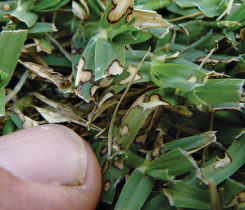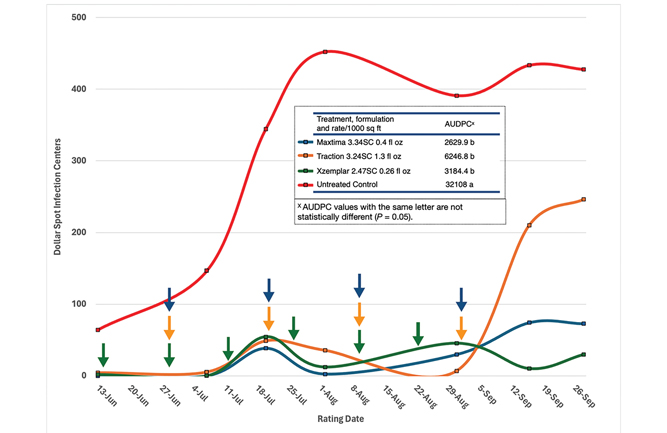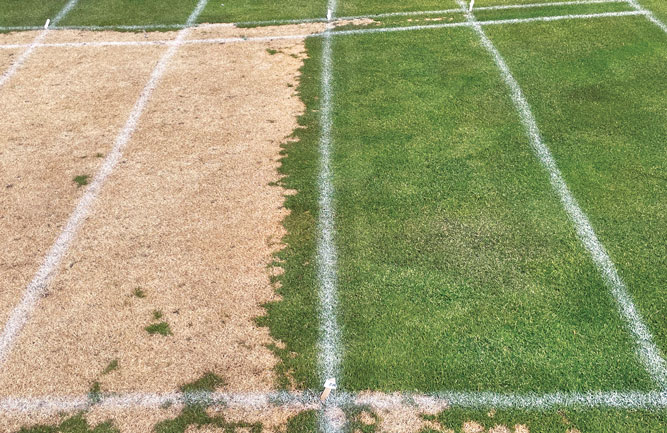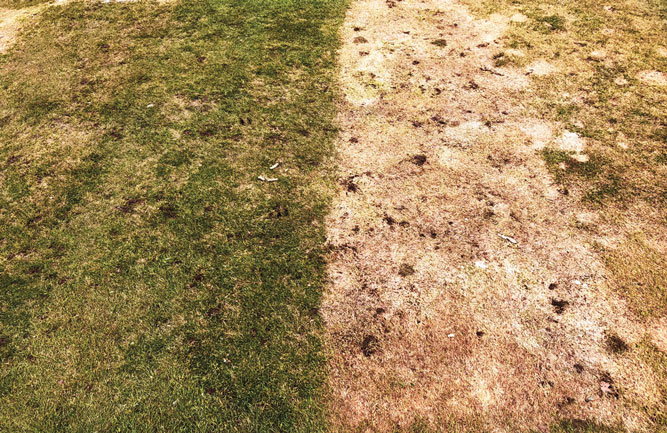Super Science: Preventive fungicide applications for dollar spot control on creeping bentgrass fairways
Fungicides often are required for the successful management of dollar spot (Clarireedia spp.). However, it is essential to note that repeated use of similar active ingredients can lead to dollar spot-resistant populations.

Recently released Posterity, Xzemplar and Maxtima provided effective dollar spot control. (Photo: Paul Koch, Ph.D.)
During the summer of 2019, we evaluated several fungicide products and combinations at the O.J. Noer Turfgrass Research and Education Facility in Madison, Wis. (Table 1).
The experiment was on a creeping bentgrass (Agrostis stolonifera Penncross) fairway maintained at 0.5 inch and grown on a native silt loam root zone. Individual plots measured 3 feet by 5 feet and were arranged in a randomized complete block design with four replications.
Treatments were applied at a nozzle pressure of 40 psi using a CO2-pressurized boom sprayer equipped with two XR TeeJet AI8004VS nozzles. Fungicides were agitated by hand and applied in the equivalent of 1.5 gallons of water per 1,000 square feet. All treatments were initiated on May 20, and subsequent applications were made at 14-, 21-, 28-, or 35-day intervals.
The experimental area was not inoculated. The number of dollar spot infection centers per plot were counted every other week from June until early September. Treatment means were subjected to analysis of variance and separated using the Fisher’s Least Significant Difference method (P = 0.05).
The Aug. 21 rating date had the highest disease pressure of the season, and every treatment except for one reduced disease relative to the nontreated control on this date (Table 2). We did not observe phytotoxicity with any treatment (data not shown).
A total of 12 of the 21 treatments provided effective dollar spot control (< 5 spots per plot) on the Aug. 21 date, including recently released products from the succinate dehydrogenase inhibitor (SDHI) class such as Posterity and Xzemplar, the demethylation inhibitor (DMI) class such as Maxtima and products containing mixtures of active ingredients like Traction.

Application Code B = May 20, C = May 28, D = June 4, E = June 11, F = June 18, G = June 25, H = July 2, I = July 10, J = July 16, K = July 24, L = July 30, N = August 13, O = August 21. Means followed by the same letter do not significantly differ according to the Fisher’s LSD test (P = 0.05). DuraPhite 12 is a combination of potassium phosphite (12 percent K2O) and manganese phosphite (2 percent Mn). Extreme Green 20 is derived from ferrous sulfate heptahydrate and contains 12 percent sulfur and 20 percent iron. Ambient Plus is a turf color enhancer and has no known effects on dollar spot severity. MoCa 5-0-5 contains Ca (1.0 percent), Cu (0.05 percent), Fe (0.1 percent), Mn (0.05 percent), Mo (0.0005 percent), and Zn (0.05 percent).
There are several excellent options for dollar spot control on bentgrass fairways. Using a combination of products with different modes of action will prolong their usefulness by preventing pathogen-resistant strains.
Research takeaways
- All of the treatments provided some level of control relative to the
nontreated plot. - None of the treatments were phytotoxic to creeping bentgrass maintained as a golf course fairway.
- Twelve of the 21 treatments provided effective season-long dollar spot
control (less than five spots per plot). - Recently released Posterity, Xzemplar, Maxtima and the combination product Traction provided effective dollar spot control.
Paul Koch, Ph.D., and Kurt Hockemeyer are at the University of Wisconsin. Contact Koch via email at plkoch@wisc.edu.
Reference
Adapted from Plant Disease Management Reports, Volume 14, March 9, 2020













